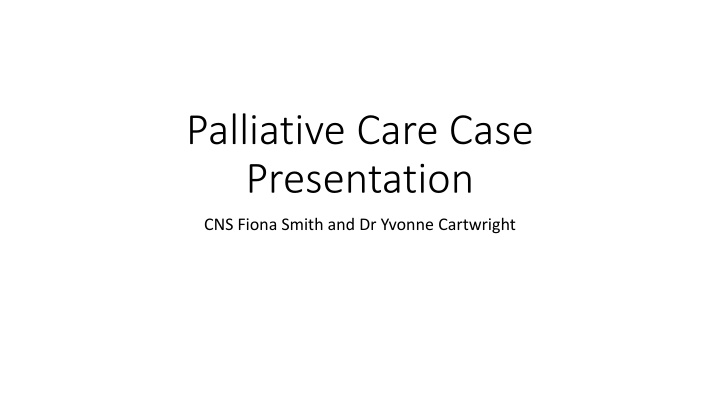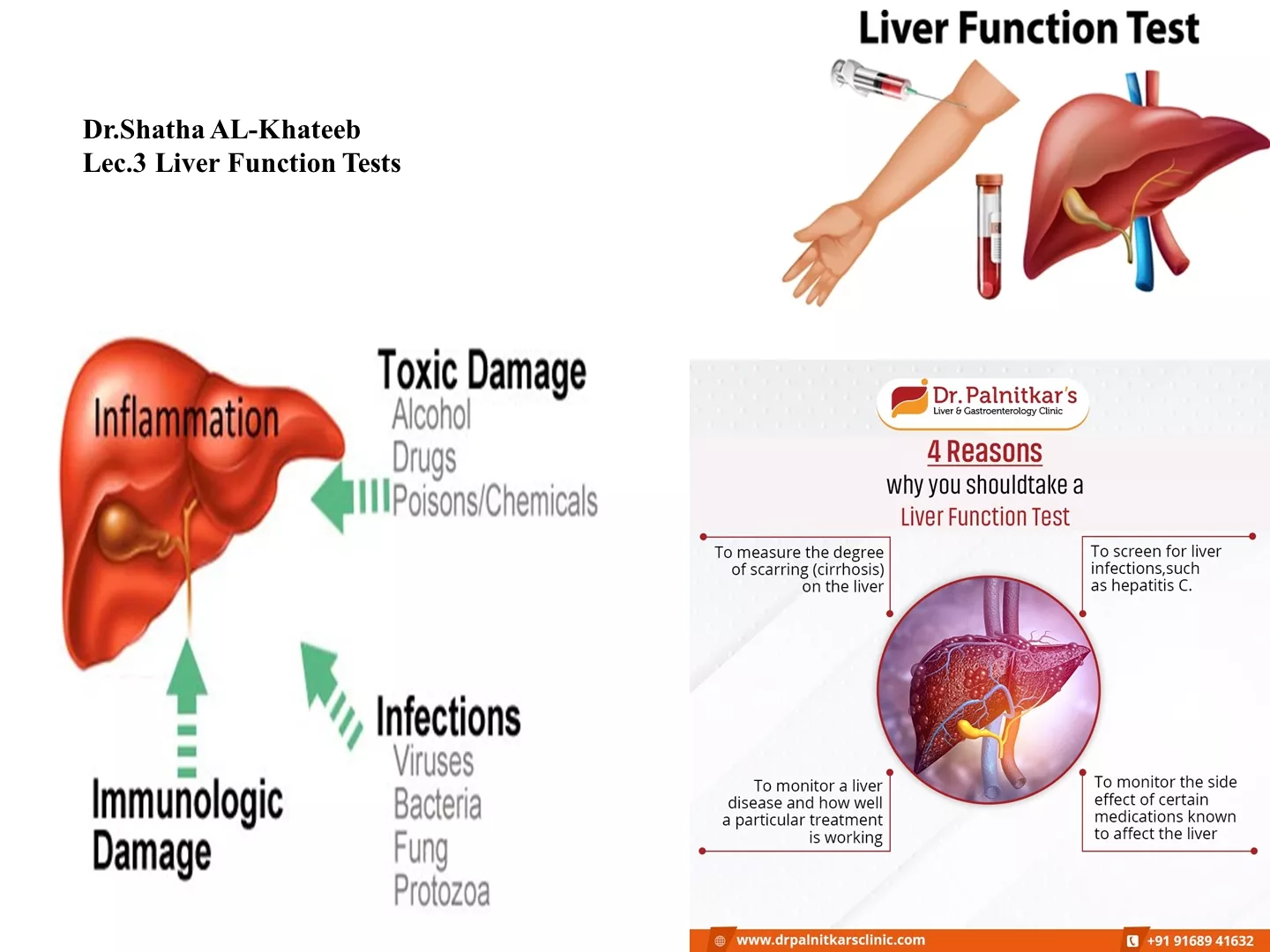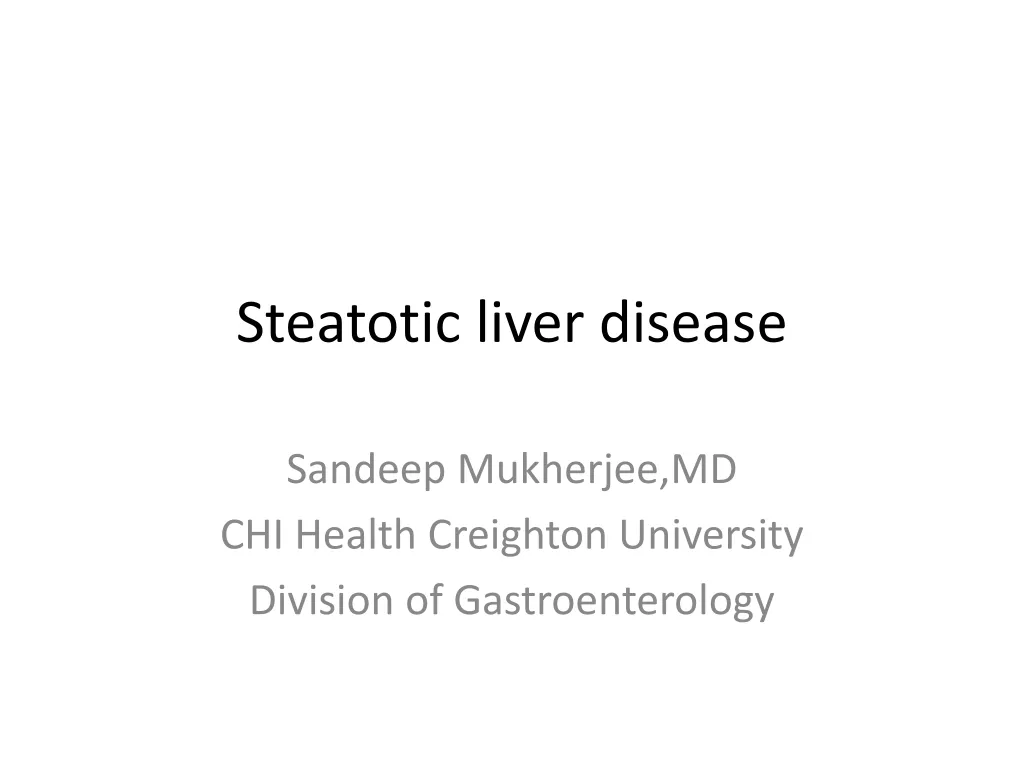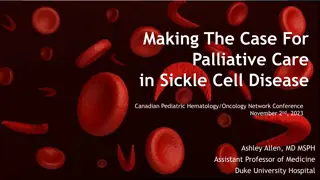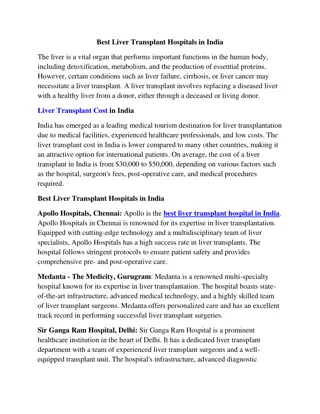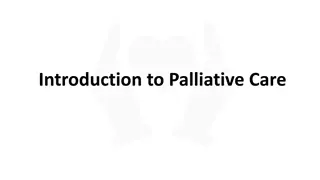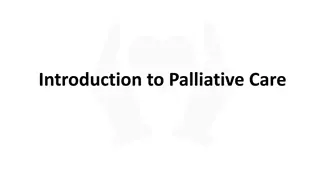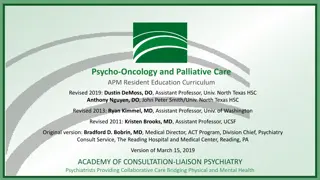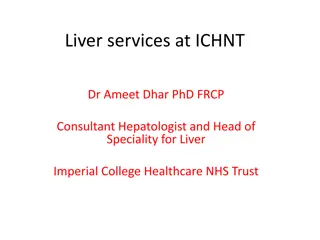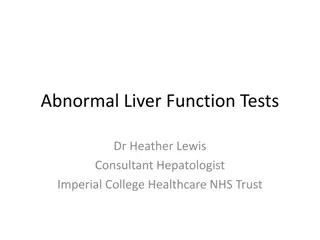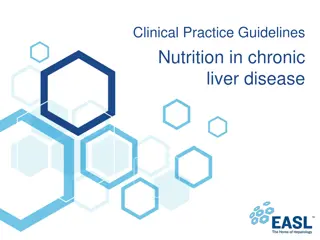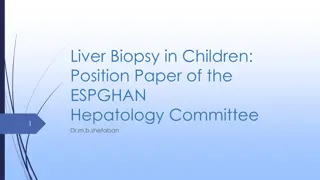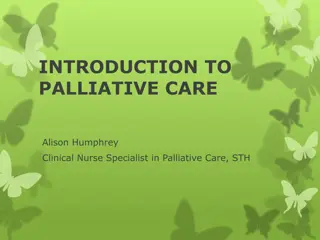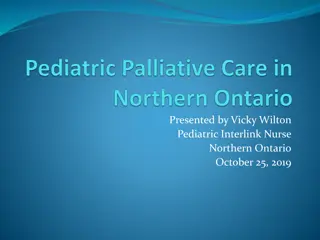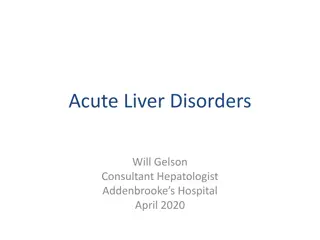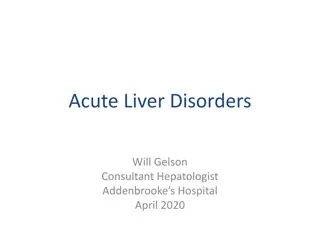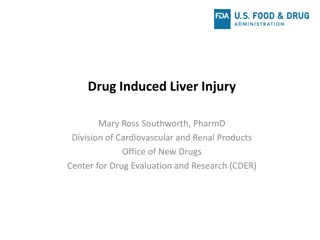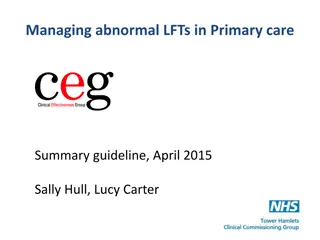Palliative Care in End-stage Liver Disease: Challenges and Perceptions
The mortality rate from chronic liver disease is increasing, with patients facing symptom burdens comparable to cancer. Specialist Palliative Care input for patients with Hepatocellular Carcinoma and End-stage Liver Disease encourages advance care planning and reduces healthcare costs. However, Hepatologists often perceive Palliative Care more suited for cancer patients, leading to uncertainties in referral criteria and medication choices for symptom control. Addressing misconceptions is crucial for optimal care provision in liver disease.
Download Presentation

Please find below an Image/Link to download the presentation.
The content on the website is provided AS IS for your information and personal use only. It may not be sold, licensed, or shared on other websites without obtaining consent from the author.If you encounter any issues during the download, it is possible that the publisher has removed the file from their server.
You are allowed to download the files provided on this website for personal or commercial use, subject to the condition that they are used lawfully. All files are the property of their respective owners.
The content on the website is provided AS IS for your information and personal use only. It may not be sold, licensed, or shared on other websites without obtaining consent from the author.
E N D
Presentation Transcript
Palliative Care Case Presentation CNS Fiona Smith and Dr Yvonne Cartwright
DH NASH cirrhosis with portal hypertension diagnosed 2011 2014-2018 - 6 monthly cirrhosis surveillance. Stable Evidence of decompensation 2018 found to have moderate ascites on scan and bilateral leg oedema- started Spironolactone, Ciprofloxacin and had monthly review from this point Age 73, Type 2 diabetes mellitus, Ischaemic heart disease, COPD September 2018- discussion with Hepatology CNS that liver disease would deteriorate, in-dwelling drain inserted and referred to ESC Weekly paracentesis from September 2018-May 2019 including one day before his death At ESC appointment- commenced antidepressant for low mood, supported to claim PIP, encouraged to update will and referred to Community Palliative Care Support reviewed in Advanced Liver Disease MDT April 2019; all in place Died May 2019 without readmission to an Acute Trust
Palliative Care in End-stage Liver Disease (ESLD) Mortality rate from chronic liver disease in the UK is rising rapidly Patients with advanced disease have a symptom burden comparable to cancer and other life-limiting conditions Liver disease strongly associated with significant social, psychological and financial hardships for patients and carers; early MDT involvement helpful The unpredictable trajectory of the disease makes prognostication difficult 70% of patients with Advanced Liver Disease die in hospital Specialist Palliative Care input for patients with HCC and ESLD has been shown to encourage advance care planning, reduce in-hospital deaths and reduce healthcare costs
Hepatologist Perceptions Palliative Care more suitable for those with cancer than without Feel they should have initial conversations about ACP Are unclear about the referral criteria for Specialist Palliative Care May be uncertain about appropriate medications for symptom control May believe that Palliative Care is synonymous with End of Life care Feel that Palliative Care involvement is inappropriate for patients still being considered for transplantation
Role of the Hepatologist Recognition of decompensated cirrhosis and early consideration of appropriate treatment options Is liver transplantation a feasible consideration or clearly precluded? If so, transplant assessment, but bringing transplant into discussion enables discussion about prognosis. Palliative Care can be involved in parallel with being on Transplant w/l. If not early discussion about stage of disease and prognosis This leads to Planning of management of decompensation events offer of earlier Palliative Care input -> timely referral to Specialist Palliative care either hospital or community based (both may be appropriate) Timely conversations about treatment escalation plans (including CPR), admission criteria (if appropriate), preferred place of care and death
The Gold Standards Framework Proactive Identification Guidance (PIG) General Indicators of Decline Liver specific indicators Refractory Ascites Encephalopathy Malnutrition Hepatorenal dysfunction bacterial infection, recurrent bleeds, raised INR and hyponatraemia Untreatable HCC Deemed ineligible for tranplant
SPICT Supportive and Palliative Care Indicators Tool (SPICTTM) Specific Liver Indicators Cirrhosis with one or more complications in the past year - Diuretic resistant ascites - Hepatic encephalopathy - Hepatorenal syndrome - Bacterial Peritonitis - Recurrent variceal bleeds
Assess Symptoms needing assessment commonly include; pain, breathlessness, muscle cramps, sleep disturbance, depression, anxiety, fatigue and erectile dysfunction
IPOS Patients are asked to rate their symptom severity on a 5 point scale They are also asked about the emotional well-being of themselves and their families They also rate how well-informed they feel about their illness and their involvement in management plans Renal and Palliative Care Physicians have worked together to produce a disease specific IPOS
Management of Ascites 60% of patients with cirrhosis develop ascites; those with refractory ascites have a median survival of less than 6months Day-case Paracentesis known to reduce healthcare costs, days spent in hospital and leads to reduced risk of dying in hospital Indwelling drain and alfapump have similar safety profile to large volume paracentesis and are well evaluated in terms of HR-QOL Pragmatic guidelines as to when/if HAS replacement can be discontinued would be extremely helpful
Management of Encephalopathy Distressing for patients and carers Patients and carers often unaware that it is a potential complication of ESLD until it occurs for the first time Optimal management of Hepatic Encephalopathy can have a significant effect on Health-related QOL and reduce hospital admissions - Increases understanding of the condition - Involves encouraging patients and carers to adjust laxative and enema doses - Involves early consideration of the use of Rifaximin Dietician input also well evaluated
Malnutrition Optimising nutrition can improve cognition in Hepatic Encephalopathy as well as quality of life Early dietician involvement likely to be helpful All members of the multi-disciplinary team should be able to give simple advice such as the role of a bedtime snack
Symptom Management Recently published pragmatic guidelines from BASL PATIENT GROUP: Adult patients with Child Pugh B or C cirrhosis who are experiencing symptoms which interfere with their quality of life https://www.basl.org.uk/uploads Avoid Oxycodone as t1/2 triples in liver impairment Fentanyl or Alfentanil probably sc opioid in last days of life in co- existent renal impairment
Plan Issues to consider Identifying advocates Wishes regarding CPR, treatment escalation and hospital admission Important that patients and families are aware of uncertain trajectory Preferred priorities of place of care and of death Patient and Carer preferences particularly around personal care Specific liver issues Surveillance endoscopies HCC screening Treatment of SBP Management of encephalopathy
Successful interventions (1) Advanced Liver Disease MDT and Community Liver Disease Nurse- Western Sussex NHS Foundation Trust and St Barnabus House Hospice - MDT comprises Hepatology and Palliative Care Consultants, Community Liver Disease Nurse, Alcohol Liaison Services and Social Worker - 77% of patients dying of ESLD in region had Palliative Care input - only 28% of patients known to the service died in hospital
Successful Interventions (2) Palliative Care Clinical Nurse Specialist for Liver Services at Royal Free Hospital - inpatient Palliative Care CNS works alongside Hepatology and Hepatobiliary Teams - weekly MDT and board rounds and a research and educational role - Referrals for Specialist Palliative Care input for non-malignant disease have increased by 227% in one year
Successful Interventions (3) Exeter Advanced Liver Disease MDT - All patients with a new episode of decompensated liver disease are discussed in an MDT with hepatology and palliative care clinicians, dietician, physiotherapy, occupational therapy, alcohol support worker and member of the local hospice team - Ceiling of care agreed and discussed with the patient and carer - If appropriate an emergency management plan is formed which is integrated within online medical records and therefore available to those attending the patient out of hours
References Palliative care in liver disease: what does good look like? Woodland H et al Frontline Gastroenterology 2020; 11:218-227 Public Health England Statistical commentary: end of life care profiles, 2018 Supportive and Palliative care in people with cirrhosis: international systematic review of the perspective of patients, family members and health professionals Low JTS et al J Hepatol 2018; 69:1260-73 Advance Care planning (ACP) for specialists managing cirrhosis: a focus on patient-centred care Brisebois A et al Hepatology 2018; 67:2025-40
References cont A pre-emptive Palliative Care intervention resulted in increased time to first readmission and more days alive outside the hospital in the first six months after study entry
Aiming to compare the efficacy of Consultative Palliative Care with Hepatologist-led Palliative Care Watch this space Introducing Palliative Care within the Treatment of End-Stage Liver Disease: The Study Protocol of a Cluster Randomized Controlled Trial Manisha Verma, MD, MPH,1 Andrzej S. Kosinski, PhD,2 Michael L. Volk, MD,3Tamar Taddei, MD,4 KavithaRamchandran, MD,5 Marie Bakitas, DNSc, NP-C, FAAN,6Kenneth Green,7 Lisa Green,7 and Victor Navarro, MD1 Methods: This two-arm, multicenter cluster-randomized trial assesses the effectiveness of two PC models for patients with ESLD. Fourteen clinical centers will recruit 1260 patient caregiver dyads. Each center is the unit of randomization. Hepatologistsat sites randomized to the Model 2 have undergone web-based training in the principles of PC as pertained to ESLD. PC intervention is delivered over four visits (initial, one, two, and threemonths). Follow-up assessments occur at 6, 9, and 12 months. Eligible patients are those with new onset or ongoing complications of ESLD with a caregiver willing to participate. Outcomes: The primary outcome is change in patients QOL from baseline to three months. Secondaryoutcomesinclude symptom burden, depression, distress, satisfaction with care, caregiver burden and QOL, goal concordant care, and health care utilization.
